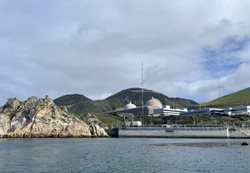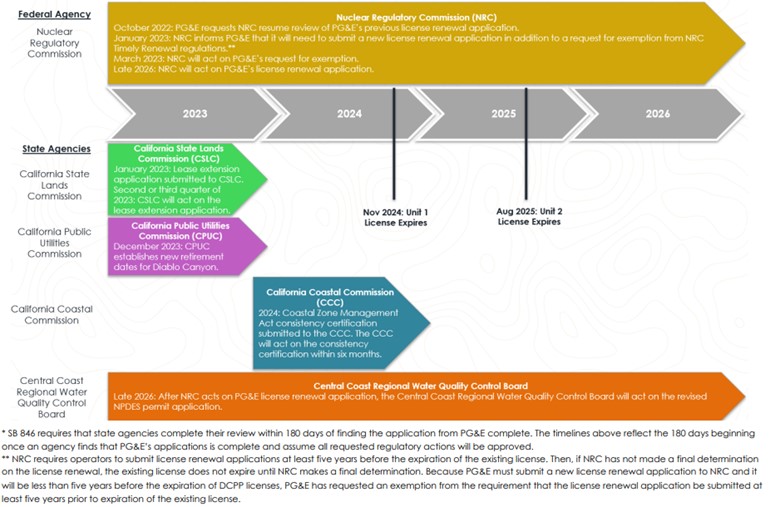Diablo Canyon Power Plant Extended Operations
 On September 2, 2022, Governor Newsom signed Senate Bill 846 into law, providing a path for Pacific Gas and Electric Company (PG&E) to extend operations at its Diablo Canyon Power Plant (DCPP) beyond the current expected closures of 2024 (Unit 1) and 2025 (Unit 2). There are numerous provisions in the new law that require proceedings spanning multiple State and Federal agencies. Links to the various agencies proceedings are provided below in the Frequently Asked Questions section. See "Which Agencies are involved in implementing SB 846".
On September 2, 2022, Governor Newsom signed Senate Bill 846 into law, providing a path for Pacific Gas and Electric Company (PG&E) to extend operations at its Diablo Canyon Power Plant (DCPP) beyond the current expected closures of 2024 (Unit 1) and 2025 (Unit 2). There are numerous provisions in the new law that require proceedings spanning multiple State and Federal agencies. Links to the various agencies proceedings are provided below in the Frequently Asked Questions section. See "Which Agencies are involved in implementing SB 846".
FAQs
Source: Diablo-Canyon-Detailed-Description-and-Plan.pdf
In January 2024, the federal Department of Energy announced its final decision to award PG&E $1.1 billion as part of the Department of Energy Civil Nuclear Credit Program. Previously, PG&E entered into a prescribed loan agreement with the California Department of Water Resources, which would provide up to $1.4 billion from state funds to support DCPP extended operations as long as the provisions of SB 846 are met by the utility. The $1.1 billion provided by the Department of Energy could be used to repay the loan from the Department of Water Resources.
The federal Nuclear Regulatory Commission (NRC) is currently reviewing PG&E’s License Renewal Application for the DCPP. PG&E’s application requests that the plant licenses be extended for 20 years. The application was filed with the NRC on November 7, 2023. On December 19, 2023, the NRC determined that the application is sufficient for the NRC to begin its safety and environmental review. The NRC hopes to complete its review of the application and its Environmental Impact Statement in 20 months. The NRC anticipates making a decision on the
License Renewal application in April 2025. Information on the NRC DCPP License Renewal proceeding can be found here:
The California Natural Resources Agency (CNRA), which oversees the Department of Water Resources, California Energy Commission, California Coastal Commission, and the California State Lands Commission, among other state agencies, is tasked with the bulk of implementing SB 846. CNRA is also the lead agency for development of a Land Conservation and Economic Development Plan, which was submitted to the state legislature in May 2023. As part of SB 846 and the Land Conservation and Economic Development Plan, the State Coastal Conservancy and Go-Biz were both allocated $5 million as part of the state 2023/24 budget. Pursuant to SB 846, the State Coastal Conservancy will use its funds for environmental enhancements and access to the 12,000-acre Diablo Canyon lands. Go-Biz will use its funds for local economic development associated with the DCPP site.
In January 2023, the California Public Utilities Commission (CPUC) opened a new rulemaking to implement SB 846 (R.23-01-007). SB 846 requires CPUC participation in joint-agency evaluations of the amount of energy will be necessary from DCPP to meet statewide reliability goals, and the CPUC is responsible for approving any potential incremental costs related to continued operations that could be passed to ratepayers. On December 14, 2023, the CPUC issued a decision conditionally approving the extended operations of the DCPP until 2029 for Unit 1 and 2030 for Unit 2.
The California Energy Commission (CEC) is participating in the evaluation of the ongoing need for power from DCPP and supporting ongoing studies about the plant’s operating safety. SB 846 is being implemented through its Energy System Reliability proceeding (Docket 21-ESR-01). In February 2023, the CEC approved a staff analysis recommending the state pursue extending operation of Diablo Canyon Power Plant (DCPP) through 2030 to ensure electricity reliability. The determination is based on data showing California risks energy supply shortfalls during extreme weather events driven by climate change. In addition, On May 26, 2023, the CEC issued an SB 846-mandated report describing opportunities to shift electric demand from peak hours. It is available for download at Senate Bill 846 Load-Shift Goal Report | California Energy Commission.
The Diablo Canyon Independent Safety Commission (DCISC) is funded through PG&E ratepayer dollars and tasked with ensuring the DCPP operates safely. SB 846 requires the DCISC to review the seismic safety of the DCPP buildings and to update studies related to earthquake faults near the plant. The Committee holds public meetings and plant tours, conducts inspections and publishes an annual report on the safety of Diablo Canyon, assisted by technical consultants and legal counsel. Its next meeting is scheduled for February 21-22, 2024, in Avila Beach. Information of the DCISC can be found here:
(Diablo Canyon Independent Safety Committee) (dcisc.org)
The Diablo Canyon Independent Peer Review Panel (IPRP) was developed in response to Assembly Bill 1632, which required the CEC to determine whether the state’s nuclear plants are potentially vulnerable to seismic or other major natural disruptions. The IPRP is overseen by the CPUC, which determines the costs of the DCPP’s safe operations. The IPRP is tasked with consulting with the DCISC about the safety of the plant’s operations during its existing license period and safety related issues associated with continued operations.
The California State Water Resources Control Board in January 2023 issued a draft amendment to its Once-Through Cooling (OTC) Policy to extend DCPP’s compliance date to October 31, 2030. The Water Board regards this as a nondiscretionary change without regulatory effect to make the policy consistent with the compliance date extended by the Legislature in SB 846. More information about the draft changes in the OTC regulation is available at draft-amendment.docx (live.com).
The California State Lands Commission in June 2023 approved a lease extension authorizing PG&E to continue its existing use of public lands beneath the mean high-tide line for DCPP continued operations through October 31, 2030. Details on the lease extension can be found here: Staff Report 90 (windows.net)
The County of San Luis Obispo is actively engaged in the legislative and regulatory processes regarding the future of the DCPP. As the host community for the plant, the County welcomes working with federal, state, and local partners to plan for the future of the DCPP. The plant plays a significant role in the County’s economy and community, and we are working to ensure the community’s interests are represented in the safety, environmental, and other regulatory processes and decisions that lie ahead. Above all, the safety of the community remains the utmost priority of the County.
The County’s Planning and Building Department provides oversight of the unincorporated areas of San Luis Obispo County. It performs all land use planning functions, including permitting, environmental review and zoning enforcement. No action is needed from the Planning and Building Department to extend the operations of the DCPP. The DCPP has a current land use permit that covers its operations. That land use permit will cover the extended operations of the DCPP as long as PG&E’s proposed operations plan does not create any new processes that would trigger the need for a new land use permit. PG&E confirmed that it does not intend to create any new processes that would require a new land use permit.
The County remains focused on how the DCPP site can strengthen and diversify our economy and provide high-wage job opportunities today and in the future. The County continues to support concepts that would repurpose DCPP’s facilities, infrastructure, and remediated site in ways that meet the community’s needs. In May 2022, the Board of Supervisors unanimously agreed to sign onto multistakeholder vision of a cleantech innovation hub at the site. The County is also engaged in the efforts to identify and plan for the conservation of 12,000 acres of land surrounding the site.
The California Natural Resources Agency (CNRA) is the lead agency for development of a Land Conservation and Economic Development Plan, which is expected to make recommendations to the state legislature on how the $160 million of funds mentioned in SB 846, if allocated, would support future use of the Diablo Canyon lands. Information about the development of this plan is available on Transitioning to Clean Energy (ca.gov)
The California Public Utilities Commission’s (CPUC) Tribal Land Transfer Policy will also play a significant role in determining how Diablo Lands could be transferred, which will be considered in CNRA’s process. More information about this Policy and its implementation is available at Tribal Land Transfer Policy (ca.gov).
The County’s Planning and Building Department is the lead agency overseeing the California Environmental Quality Act (CEQA) review of PG&E’s proposal to decommission the DCPP. PG&E applied for a Development Plan/Coastal Development and Conditional Use Permit in 2021 and County staff have been preparing an Environmental Impact Report (EIR) pursuant to CEQA. Although SB846 seeks to preserve the option to extend the operational life of the plant, County staff continues to work toward finalizing the EIR, given the numerous provisions of the legislation that could lead to the closure of DCPP on schedule. More information about the CEQA process for the Decommissioning Project is available at Diablo Canyon Power Plant Decommissioning - County of San Luis Obispo.
The California Public Utilities Commission (CPUC) evaluates and approves PG&E’s projected costs associated with decommissioning DCPP through its Nuclear Decommissioning Triennial Proceeding (NDCTP), which PG&E files every three years. The current NDCTP docket is Application (A.) 21-12-007.


